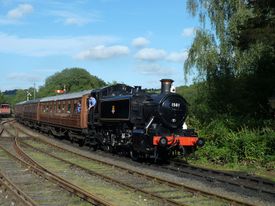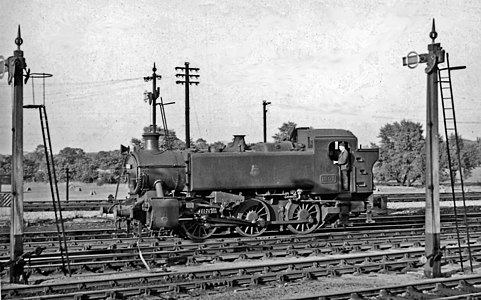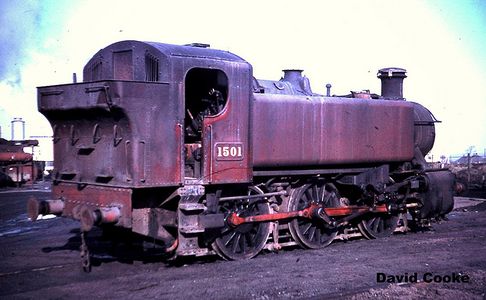Difference between revisions of "GWR Pannier 1501"
m (Typo) |
m (→Trivia: typo) |
||
| Line 66: | Line 66: | ||
==Trivia== | ==Trivia== | ||
| − | As noted above, 1501 is a member of the GWR 1500 class, also referred to as the 15xx Class. 108 0-6- | + | As noted above, 1501 is a member of the GWR 1500 class, also referred to as the 15xx Class. 108 0-6-0ST tank engines of the 645 Class were built at the GWR’s Wolverhampton works between 1872 and 1881. The last 72 of these featured a revised design; the first of which was numbered 1501. This modified sub-class is therefore sometimes referred to as the “1501 Class”.<ref>[https://en.wikipedia.org/wiki/GWR_645_Class 645 Class on Wikipedia]</ref> |
==See also== | ==See also== | ||
Revision as of 21:19, 25 April 2022
| GWRGreat Western Railway Pannier 1501 | |
|---|---|
 1501 approaching Highley in 2012 | |
| Built By | BRBritish Rail or British Railways Swindon Works |
| Configuration | 0-6-0PT |
| Power class | GWRGreat Western Railway: C, BRBritish Rail or British Railways: 4FThe British Railways system of classifying steam locomotives by power using a number from 0, least powerful, to 9, most powerful, followed by either F for freight, P for Passenger or MT for Mixed Traffic. |
| Axle load class | GWRGreat Western Railway: Red |
| Status | In use |
| Loco Number | BRBritish Rail or British Railways 1501 |
| History | |
| Built | 1949 |
| Type | GWRGreat Western Railway 1500 |
| 1961 | Withdrawn by BRBritish Rail or British Railways |
| 1970 | Acquired by SVRSevern Valley Railway |
| 1997 | First entered service |
| 2012 | Re-entered service |
| Technical | |
| Weight | 58t 4cwt |
| Tractive effort | 22,515 lb |
| Pressure | 200 lb/sq in |
1501 in service
British Railways
1501 entered service on 31 July 1949[2] at London’s Old Oak Common, where duties included hauling long rakes of empty coaching stock in and out of Paddington Station. On 30 November 1950[2] the locomotive was reallocated to Southall for local shunting duties.
The BRBritish Rail or British Railways modernisation programme led to a swift replacement of the 1500 class by 350hp diesel shunters, and 1501 was withdrawn from service at Southall by BRBritish Rail or British Railways in January 1961[2] after a working life of just 11 years 5 months. Following withdrawal, 1501 was moved to Swindon. Two other class members, 1502 and 1509, were also moved to Swindon after withdrawal from Didcot and Newport respectively, and in February 1961 all three were sold to the National Coal Board[1].
National Coal Board
In June 1961 all three locomotives were towed by rail via Bagnalls at Stafford to the Andrew Barclay works at Kilmarnock for repairs and a repaint into unlined maroon livery. Later in the year they returned by road to the colliery at Keresley, Coventry where, still carrying their BRBritish Rail or British Railways numbers, they worked in the NCBNational Coal Board sidings and on the two mile branch line to the Coventry to Nuneaton line at Three Spires Junction. 1969 saw the locomotives once again replaced by diesel shunters, with 1501 the last of the three in use until September of that year.[1]
1501 in preservation
All three locomotives were inspected during 1969 and reserved by members of the Warwickshire Railway Society and SVRSevern Valley Railway. After this inspection and consultation with NCBNational Coal Board staff, 1501 was selected for preservation on the SVRSevern Valley Railway and an appeal for funds appeared in the Autumn 1969 edition of SVRSevern Valley Railway News.[3] The other two were used as a source of parts for restoring 1501 and other ex-GWRGreat Western Railway locomotives lacking fittings at BarryWoodham Brothers Scrapyard, Barry, South Wales. The source of many locomotives now in preservation. following vandalism, after which the remains were sold for scrap and cut up at Cashmores, Great Bridge in October 1970.[1]
1501 was initially towed by rail from Coventry to Tyseley in July 1970 for wheel turning, before a further move behind a diesel to Bewdley on 17 October 1970. During the latter move, excessive speed caused damage to one of 1501’s axle boxes.
A lengthy restoration was undertaken, largely through the endeavours of the 15xx Pannier Tank Fund with financial assistance from the Warwickshire Railway Society. Restoration began at Bridgnorth but initially progress was slow as the locomotive had only a small support group to provide funds and labour. By summer 1977, following several years of inactivity, disposal of the locomotive was under consideration, but a small team at Bewdley swayed the decision and the engine was moved to Bewdley where restoration restarted. The proceeds of an SVRA raffle in 1980 were also used to help fund the restoration.[4]
Work on the locomotive initially concentrated in two areas, the bunker and the axleboxes with their associated suspension. The boiler was lifted by a road crane on 30 April 1982.[5] Another road crane was hired on 9 September 1983 to re-wheel the locomotive and lift the rebuilt bunker and cab roof back into place.[6] A further SVRASevern Valley Railway Association raffle was organised in 1987 to help the restoration,[7] following which progress continued slowly as funds and labour permitted.
On 5 April 1996 the locomotive was towed to Bridgnorth for completion of the boiler work, including fitting the new smokebox door and performing a boiler hydraulic test and steam test. By that time the locomotive had been fitted with all of its motion and valve gear, although it was the first time that it had moved more than a few feet in that condition. Following the boiler steam test on 25 July, the locomotive returned to Bewdley on Sunday 4 August. The boiler lagging was refitted, and arrangements then made to move the locomotive to Kidderminster Carriage Works over the Christmas holidays, where Mike Hill and Brian Hill worked around 10 hours a day for 12 of the 13 days in near-freezing temperatures to complete the painting. The locomotive was returned to Bewdley on 3rd January where the water tanks were refitted on 25 January.[8] 1501 was first steamed on 29 May 1997.[1]
Over the next 10 years the locomotive was re-tyred but otherwise served a full ‘ticket’ before being taken out of service at the end of 2006. 1501 then became one of the first group of locomotives to be displayed in the Engine House from opening in March 2008.[9]
During 2009, plans for an overhaul of 75069 were delayed after a review of the boiler revealed that significant work would be required.[10] 1501 was seen as a potential quick turnaround,[11] and the locomotive left the Engine House in October 2009[12] to begin an overhaul. 1501 was steamed again on 15 August 2012, re-entering service in BRBritish Rail or British Railways lined black livery which, although not normally appropriate for shunting engines, was carried by 1503 and 1505 while at Old Oak Common.[13]
A Valve and Piston overhaul in 2020 was completed in August 2020, only for a severe crack to be discovered in the right hand return crank. Fortunately, a replacement return crank was in store from its long scrapped sisters at Coventry Colliery.[14] The boiler certificate runs to February 2022 and an extension has been requested.[15][16]
In service on the SVRSevern Valley Railway, 1501 has proved a powerful locomotive for its size, acquiring the nickname “the raging bull”. At the end of 2019, 1501 had recorded a total of 98,933 miles in preservation on the SVRSevern Valley Railway. The reported total may include mileage on hire to other railways.[17] The locomotive is owned by the 1501 Pannier Tank Association.
Trivia
As noted above, 1501 is a member of the GWRGreat Western Railway 1500 class, also referred to as the 15xx Class. 108 0-6-0ST tank engines of the 645 Class were built at the GWRGreat Western Railway’s Wolverhampton works between 1872 and 1881. The last 72 of these featured a revised design; the first of which was numbered 1501. This modified sub-class is therefore sometimes referred to as the “1501 Class”.[18]
See also
References
- ↑ 1.0 1.1 1.2 1.3 1.4 SVRSevern Valley Railway Stock Book 9th Edition
- ↑ 2.0 2.1 2.2 BRDatabase.info
- ↑ SVRSevern Valley Railway News 14
- ↑ SVRSevern Valley Railway News 45, 56
- ↑ SVRSevern Valley Railway News 65
- ↑ SVRSevern Valley Railway News 78
- ↑ SVRSevern Valley Railway News 85
- ↑ SVRSevern Valley Railway News 122
- ↑ SVRSevern Valley Railway News 161
- ↑ SVRSevern Valley Railway News 168
- ↑ SVRSevern Valley Railway News 169
- ↑ Wikipedia
- ↑ SVRSevern Valley Railway News 179
- ↑ Branch Lines newsletter, September 2020 (Retrieved 29 August 2020)
- ↑ SVRSevern Valley Railway News 207, pp. 17, 44-46
- ↑ SVRSevern Valley Railway News 216, p. 17
- ↑ SVRSevern Valley Railway News 210, SVRSevern Valley Railway-based Steam Locomotive Mileage 2017-2019, Duncan Ballard
- ↑ 645 Class on Wikipedia
Links
| ||||||||||||||||||||||||||||||||||||||||||||||||||||||||

